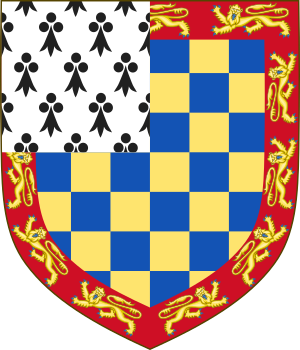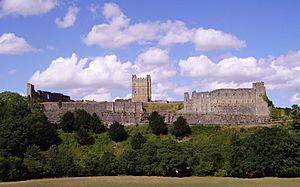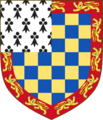John of Brittany, Earl of Richmond facts for kids
Quick facts for kids
John of Brittany
|
|
|---|---|

Arms of John of Brittany
|
|
| Born | c. 1266 |
| Died | 17 January 1334 Duchy of Brittany |
| Resting place | Church of the Franciscans, Nantes |
| Title | Earl of Richmond |
| Tenure | 1306–1334 |
| Other titles | Count of Treguier |
| Other names | Jean de Bretagne |
| Years active | 1294–1327 |
| Nationality | English, French, Breton |
| Locality | Yorkshire |
| Wars and battles | First War of Scottish Independence • Battle of Falkirk (1298) • Siege of Caerlaverock (1300) • Battle of Old Byland (1322) (POW) |
| Offices | Guardian of Scotland Lord Ordainer |
| Parents | John II, Duke of Brittany Beatrice of England |
|
|
|
John of Brittany (born around 1266, died January 17, 1334) was an important English nobleman. He was also known as Jean de Bretagne. He held the title of the 4th Earl of Richmond.
John was part of the powerful House of Dreux, which ruled Brittany. He worked for the English kings, Edward I (his uncle) and Edward II (his cousin). In 1306, he became the Earl of Richmond. He also served as Guardian of Scotland during conflicts with Scotland. Later, he was a Lord Ordainer, a group that tried to reform the government.
John was a skilled diplomat, meaning he was good at negotiating with other countries. Both Edward I and Edward II valued his abilities. He never married, and when he died, his nephew, John III, Duke of Brittany, inherited his titles. John of Brittany mostly stayed loyal to Edward II. However, he eventually supported the plan by Queen Isabella and Roger Mortimer to remove Edward II from power. After Edward II gave up his throne, John went back to his lands in France. He died in Brittany in 1334.
Contents
John's Early Life
John was the second son of John II, Duke of Brittany, and Beatrice of England. He had two brothers and three sisters who grew up. His mother, Beatrice, was the daughter of Henry III of England. This made John the nephew of King Edward I.
John's father was also the Earl of Richmond. But he was not very involved in English politics. John grew up at the English royal court. He was raised with Edward I's son, Henry, who died young. In his youth, John took part in tournaments. However, he did not become famous as a soldier early on.
Serving King Edward I
In 1294, the French king took control of King Edward I's lands in Aquitaine, France. John traveled to France to lead the English forces there. But he was not able to capture the city of Bordeaux. In 1295, he had to escape from the town of Rions. In 1297, he and Henry de Lacy, Earl of Lincoln were defeated at the Siege of Bellegarde. After these losses, he returned to England.
Even with these setbacks, King Edward I still thought highly of John. The king treated him almost like his own son. After returning to England, John joined the wars against Scotland. He was likely at the Battle of Falkirk in 1298. He was definitely at the Siege of Caerlaverock in 1300. At Caerlaverock, a special list was made of all the nobles who joined King Edward. This list, called the Roll of Caerlaverock, described each noble's banner. John of Brittany's banner and description were listed right after King Edward I's.
John's father, the Duke of Brittany, died in 1305. John's older brother, Arthur II, Duke of Brittany, became the new duke. The next year, King Edward I gave John his father's other title, Earl of Richmond. Edward I also made him Guardian of Scotland. This important position was confirmed by Edward II when he became king in 1307.
Serving King Edward II
The English court saw John of Brittany as a very trustworthy diplomat. He was excellent at negotiating. His family connections in France were also very helpful. By 1307, he was one of the oldest earls in the kingdom. As King Edward II's relationship with his nobles got worse, John remained loyal to the king. In 1309, he went to see Pope Clement V to speak for Edward's close friend, Piers Gaveston. John was said to be a good friend of Gaveston. He did not dislike Gaveston like some other earls did.
The Lords Ordainers

By 1310, King Edward II and his earls were having serious problems. A group of earls took control of the government from the king. The earls ignored a royal order not to carry weapons to parliament. They arrived in full military gear and demanded that the king appoint a committee to reform the government. The main reason for this conflict was the nobles' dislike of Piers Gaveston and the king's behavior. On March 16, 1310, the king agreed to appoint "Ordainers." These 21 people were in charge of reforming the royal household. John of Brittany was one of the eight earls chosen for this group, known as the Lords Ordainers. He was seen as loyal to Edward II and was one of the older, more experienced earls.
John then traveled to France for diplomatic talks. Later, he returned to England. The Ordainers had sent Gaveston away, but Gaveston came back without permission. In June 1312, Thomas, 2nd Earl of Lancaster, and other nobles killed Gaveston. It was John's job, along with Gilbert de Clare, to help the two sides make peace after this event. In 1313, he went with Edward II on a trip to France. After that, he generally remained a trusted supporter of the king. In 1318, he was present when the Treaty of Leake was signed. This treaty gave Edward full power again.
War with Scotland
In 1320, John went with Edward II to France again. The next year, he worked on peace talks with the Scots. In 1322, Thomas of Lancaster rebelled against the king. He was defeated at the Battle of Boroughbridge. John was there when Lancaster was put on trial and sentenced to death. After this, the English army invaded Scotland. But the Scots, led by Robert the Bruce, burned their own land. This meant the English army had no food and starved. Robert the Bruce then brought his army into England. They crossed the Solway Firth and moved towards Yorkshire.
The Scottish attack was very fast and surprising. King Edward II was staying at Rievaulx Abbey with Queen Isabella. The Scots suddenly appeared in mid-October. The only thing between them and the king was a large English force led by John of Brittany. John had taken a strong position on high ground between Rievaulx and Byland Abbey. To force John out, Bruce used the same tactics he used in an earlier battle. While Moray and Douglas attacked uphill, some Highlanders climbed the cliffs on the English sides. They then charged downhill into John of Brittany's army from behind. The English resistance broke, and the Battle of Old Byland became a complete defeat. John himself was captured. Robert the Bruce was very angry with John for how he had treated the Scottish Queen when she was a prisoner. John remained a prisoner until 1324. He was released after a ransom of 14,000 marks was paid.
After his release, he continued his diplomatic work in Scotland and France.
John's Final Years
In March 1325, John of Brittany returned to France for the last time. There, he openly opposed King Edward II. His lands in England were taken by the king. In France, John joined Queen Isabella, Edward II's wife. She had been sent to France for a diplomatic mission but refused to return to England as her husband ordered. Later, when Edward II was forced to give up his throne, his son Edward III became king. John of Brittany's English lands were given back to him. He spent his last years on his French estates. He stayed mostly out of English politics. He died on January 17, 1334. He was buried in the church of the Franciscans in Nantes, France.
John of Brittany never married and had no known children. His nephew, John III, Duke of Brittany (Arthur's son), became the next Earl of Richmond.
Images for kids


